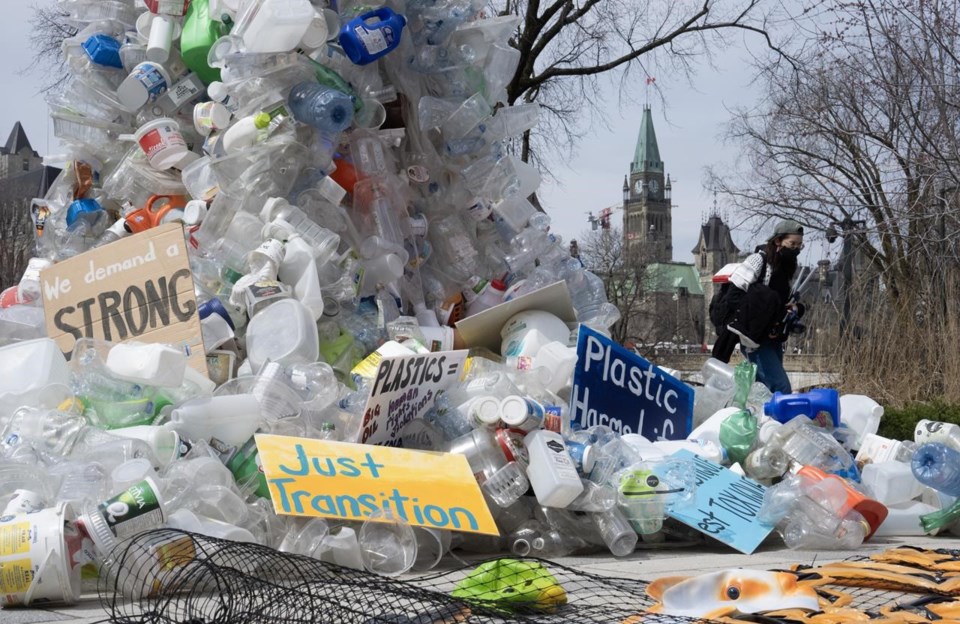OTTAWA — A First Nation in southern Ontario has a simple message for the delegates who are gathered in Ottawa this week to negotiate a treaty to curb plastic waste around the world: don't leave us out.Â
Aamjiwnaang First Nation councillor Janelle Nahmabin says Indigenous Peoples are already on the front lines of dealing with the after-effects of plastic pollution.
Leaving them out of the conversation only makes that harder, she said through tears Wednesday alongside a panel of her peers.Â
Nahmabin said she knows first-hand what it is like to deal with such pollution, growing up in an Anishinaabe community near Sarnia, Ont., in what is nicknamed Canada's "chemical valley."
So does Carrie Plain, a 27-year-old whose brother died of leukemia at 13.Â
"We know that these (chemical) plants are causing cancer," said Plain, who serves on the community's youth council. "And yet, we just have to live with that."
Aamjiwnaang First Nation is surrounded by industrial facilities and has long pushed for greater monitoring and action to protect their air quality. Earlier this month, data monitors began showing elevated levels of benzene in their community.
A nearby Ineos Styrolution plant, which produces styrene for use in making plastic, was shuttered over the weekend after employees and community members began complaining of dizziness, nausea and headaches — telltale signs of exposure to the chemical.Â
The Frankfurt-based company described the shutdown in one media report as temporary, calling the health and safety of staff and the community "paramount" and that the plant would reopen once a "mechanical issue" is addressed.Â
During Wednesday's news conference, community members described how parents were told to close the windows of their homes to keep the air out. Kids, they said, were told to stay away from the local baseball diamond.
"A lot of us now are ready to fight these chemical plants, and we're ready for change," Plain said. "Because we've been going through this for far too long. They need to start listening."
Ontario's environment ministry has issued a compliance order to Ineos, requiring it to develop a plan before the end of the week to prevent, reduce and eliminate wastewater discharge of benzene.Â
It must also implement procedures to notify the public when benzene concentrations in the air exceed certain thresholds, and by mid-May must take action to prevent, decrease and eliminate other sources of benzene discharge.
Company officials did not immediately respond to media inquiries Wednesday.Â
"As much as we've issued the order, which is the first step in resolving the matter, we'll continue to always be there to introduce any measures," said Ontario Environment Minister Andrea Khanjin.
"We need to make sure that particular company in question is accountable."
For neighbouring residents in Aamjiwnaang, billows of smoke, pollution warning alarms, evacuations and spills have become almost commonplace, Nahmabin said — but each crisis feels worse than the last.Â
"It's been my whole life growing up as a child with a sign in my hand to stop development and stop industry," she said in an interview.
"That's how I grew up, and sadly, I have to raise my children the same way."
Data from Clear Air Sarnia and Area show levels of sulphur dioxide and benzene remain labelled as poor and moderate, respectively, more than one week after they sounded the alarm.
"We're in constant reaction mode," Nahmabin said.
But as international negotiators are working on the framework for a global agreement that would seek to end plastic waste by 2040, she wants First Nations people like her to be top of mind for decision-makers.
"We're a little late to the game with this being the fourth (meeting). It would have been great if efforts would have been made to include us from the very beginning," she said.
It's a disappointing fact, she said, noting her First Nation's leadership wants to work collaboratively with governments to create a healthier future for all, but hasn't been given a platform to do so until now.
She told gathered delegates that like everyone else, Indigenous Peoples have a right to a healthy environment, and negotiations should include the duty to prevent exposure to hazardous substances.
The community's youth council also has demands for decision-makers, including that the federal and provincial governments set regulations and policies that allow for greater protection and a reduction of toxins being released into their community.
"People are getting sick and dying, and it's all for nothing," Plain said. "Just knowing the reality that maybe one day I'll get cancer; maybe I'll be next. Or maybe one day it'll by my child that I'll have to bury."
Environment Minister Steven Guilbeault said Tuesday that the treaty will not be ambitious enough if it doesn't include some limits on plastic production.
But Plain wants to see more than just words.
"How many different studies are we going to have? How many news interviews are we going to have to do — and say the same thing — before somebody actually listens?"
This report by The Canadian Press was first published April 24, 2024.
— With files from Allison Jones in TorontoÂ
Alessia Passafiume, The Canadian Press




